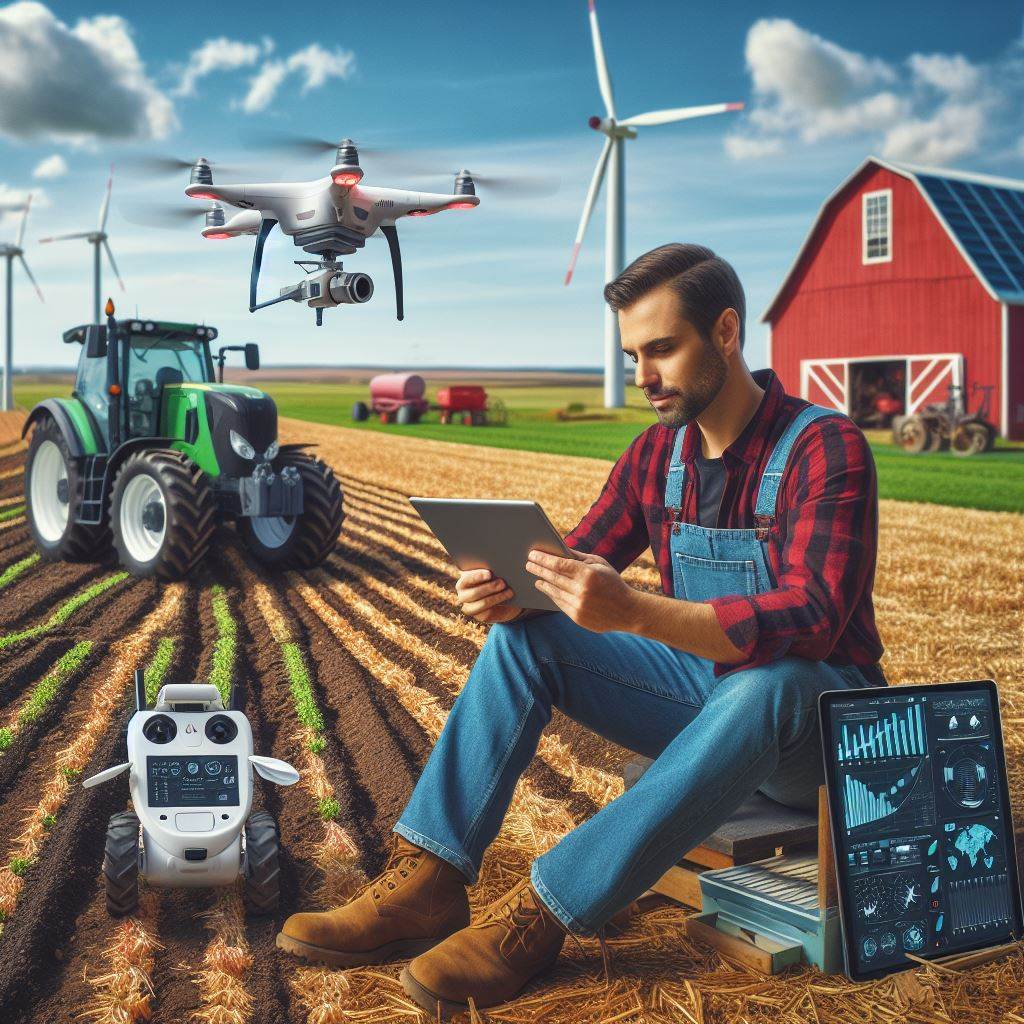Introduction
Definition of predictive analytics in agriculture
Predictive analytics in agriculture refers to the use of historical and current data to make predictions and informed decisions in the agricultural industry.
It involves analyzing data to identify patterns, trends, and potential outcomes.
Importance and relevance of predictive analytics in the agriculture industry
Predictive analytics plays a critical role in the agriculture industry by helping farmers and stakeholders make data-driven decisions.
It allows them to optimize crop yields, predict diseases, manage resources efficiently, and increase overall productivity.
With the help of predictive analytics, farmers can assess environmental factors, weather conditions, and soil data to determine the ideal time for planting and irrigation.
They can also estimate crop yield and manage resources accordingly, reducing wastage and increasing profitability.
Furthermore, predictive analytics enables early detection and prevention of diseases and pests.
By analyzing historical data and current conditions, farmers can identify potential threats and take timely action to prevent or mitigate the impact on their crops.
The use of predictive analytics in agriculture also enhances supply chain management.
By analyzing market trends and predicting demand, farmers can optimize production levels and ensure timely delivery, reducing costs and increasing customer satisfaction.
Basically, predictive analytics in agriculture empowers farmers to make informed decisions, minimize risks, and maximize yields, contributing to a sustainable and efficient agricultural industry.
Benefits of Predictive Analytics in Agriculture
Predictive analytics, a field that combines data analysis and machine learning, is revolutionizing various industries, and agriculture is no exception.
By utilizing historical data and algorithms, predictive analytics can help farmers make informed decisions and improve their crop yield, resource management, and overall productivity.
Enhanced crop yield and productivity
Farmers strive for maximum crop yield and productivity.
Predictive analytics enables them to achieve this goal by identifying potential pest and disease outbreaks at an early stage.
Transform Your Agribusiness
Unlock your farm's potential with expert advice tailored to your needs. Get actionable steps that drive real results.
Get StartedBy analyzing historical data and monitoring various environmental factors, farmers can predict the occurrence of pests and diseases accurately.
Early identification allows them to take preventive measures promptly, saving their crops from extensive damage and maximizing yield.
Moreover, predictive analytics helps farmers optimize the utilization of fertilizers and pesticides.
By analyzing various data points such as soil composition, weather patterns, and crop characteristics, farmers can determine the optimal quantity and timing of applying fertilizers and pesticides.
This targeted approach reduces waste, increases efficiency, and saves costs for the farmers.
Efficient resource management
Resource management is a crucial aspect of agriculture.
Predictive analytics helps farmers efficiently manage resources such as water, machinery, and equipment.
Precision irrigation, enabled by predictive analytics, ensures that crops receive the right amount of water at the right time.
By analyzing soil moisture levels, weather patterns, and plant water requirements, farmers can precisely control irrigation.
This approach eliminates water wastage, reduces water bills, and ensures optimal crop growth.
Additionally, predictive analytics allows farmers to perform predictive maintenance of machinery and equipment.
By analyzing historical sensor data, predictive models can detect potential machinery failures.
This proactive approach helps farmers schedule maintenance activities at the right time, preventing costly breakdowns and downtime.
Improved decision-making
Making informed decisions is critical for farmers to stay competitive and maximize profitability.
Predictive analytics provides valuable insights that aid in decision-making.
Market demand forecasting enables farmers to anticipate consumer preferences and adjust their production accordingly.
By analyzing market trends, historical sales data, and consumer behavior, farmers can accurately predict demand for various crops.
This knowledge helps them make informed decisions about which crops to cultivate, ensuring that they meet market demand and maximize their profits.
Furthermore, predictive analytics enables yield prediction, which plays a vital role in better planning.
By analyzing historical data and considering various factors such as weather patterns, soil conditions, and crop characteristics, farmers can predict their crop yield accurately.
This information helps them plan logistics, estimate revenue, and optimize their overall farming operations.
Generally, predictive analytics in agriculture offers significant benefits.
It enhances crop yield and productivity through early identification of pest and disease outbreaks and optimal utilization of fertilizers and pesticides.
It enables efficient resource management through precision irrigation and predictive maintenance of machinery.
Showcase Your Farming Business
Publish your professional farming services profile on our blog for a one-time fee of $200 and reach a dedicated audience of farmers and agribusiness owners.
Publish Your ProfileAdditionally, it improves decision-making by forecasting market demand and predicting crop yield.
Embracing predictive analytics in agriculture can revolutionize farming practices, leading to sustainable and profitable agriculture.
Read: Data Analytics in Modern Farming
Components of Predictive Analytics in Agriculture
Predictive analytics in agriculture involves several essential components that work together to optimize farming practices and increase crop yield.
These components include data collection and integration, data analysis and modeling, as well as visualization and reporting.
Data collection and integration
The first step in predictive analytics is to collect and integrate data from various sources.
Sensors and IoT devices play a vital role in this process by capturing real-time data from the fields.
These devices measure factors such as soil moisture, temperature, and humidity, allowing farmers to monitor crop conditions more accurately.
Satellite imagery and drones are also increasingly used in agriculture to gather high-resolution data.
Satellites capture images of the fields, which can be used to assess crop health, identify areas of stress, and detect potential pest or disease outbreaks.
Drones equipped with imaging sensors can provide even more detailed information about individual plants or sections of the fields.
Data analysis and modeling
After the data is collected, it needs to be analyzed and modeled to derive meaningful insights.
Statistical methods and machine learning algorithms are employed to identify patterns, make predictions, and generate recommendations for optimizing agricultural processes.
By analyzing historical data and considering various environmental factors, predictive analytics can help farmers make informed decisions and take proactive measures to mitigate risks.
Cloud computing and big data platforms play a crucial role in handling the vast amounts of agricultural data.
These technologies enable efficient processing, storage, and retrieval of data, ensuring that the analytics process can be conducted in a timely and scalable manner.
By leveraging the power of cloud computing and big data, farmers can harness the full potential of predictive analytics in agriculture.
Visualization and reporting
Once the data analysis is complete, it is essential to present the findings in a clear and intuitive manner.
Dashboards and visual analytics tools enable farmers to visualize the analyzed data, allowing them to quickly understand the current state of their crops and identify trends or anomalies.
These visualizations can range from simple graphs and charts to interactive maps and 3D models.
Furthermore, communication and sharing of insights with relevant stakeholders are crucial for effective decision-making.
Farmers can collaborate with agronomists, agricultural consultants, and other experts to interpret the results and implement necessary actions.
Sharing insights with suppliers, customers, and policymakers also enables better coordination and planning within the agricultural ecosystem.
Essentially, predictive analytics in agriculture relies on the integration of data collection, analysis, visualization, and reporting components.
By leveraging advanced technologies such as sensors, IoT devices, satellite imagery, drones, statistical methods, machine learning algorithms, cloud computing, and big data platforms, farmers can optimize their farming practices and increase crop yield.
With real-time insights and informed decision-making, predictive analytics has the potential to revolutionize the agriculture industry.
Read: Machine Learning: A Farmer’s Ally
Case Studies
Predictive analytics is revolutionizing the field of agriculture by enabling farmers to make proactive decisions.
Through the use of data analysis and predictive models, farmers can anticipate challenges and optimize their practices to maximize yields and minimize losses.
Predictive analytics in crop management
Case study 1: Use of weather data for predicting plant diseases
One example of predictive analytics in crop management is the use of weather data to predict the occurrence of plant diseases.
By analyzing historical weather patterns and disease outbreak data, farmers can identify the conditions that are conducive to the spread of diseases.
This information can then be used to implement preventive measures such as timely spraying of fungicides or adjusting irrigation practices to minimize disease risks.
Case study 2: Utilization of historical data for crop yield forecasting
Another application of predictive analytics in crop management is the utilization of historical data for crop yield forecasting.
By analyzing data such as soil quality, weather patterns, pest infestations, and crop growth rates from previous years, farmers can develop models that predict the potential yield for a given crop.
This forecasting enables farmers to make informed decisions regarding planting schedules, resource allocation, and market anticipation.
Predictive analytics in livestock management
Case study 1: Prediction of animal health and fertility issues
Predictive analytics can also be applied to livestock management to predict animal health and fertility issues.
By analyzing data such as temperature, humidity, feeding patterns, and medical records, farmers can detect patterns that indicate potential health or fertility problems.
This allows for early intervention and preventive measures, ultimately improving animal welfare and reducing economic losses.
Case study 2: Optimal feed formulation based on predictive models
Additionally, predictive analytics can help optimize livestock feed formulation.
By analyzing data on nutritional requirements, feed composition, and animal growth rates, farmers can develop models that determine the optimal feed formulation for different stages of animal growth.
Showcase Your Farming Business
Publish your professional farming services profile on our blog for a one-time fee of $200 and reach a dedicated audience of farmers and agribusiness owners.
Publish Your ProfileThis ensures that animals receive the right balance of nutrients, leading to improved growth, reduced feed costs, and increased profitability.
In general, predictive analytics plays a crucial role in modern agriculture, enabling farmers to make data-driven decisions for improved crop and livestock management.
These case studies highlight the valuable insights and benefits that predictive analytics can provide to farmers, ultimately leading to increased efficiencies, higher yields, and sustainable practices in the agricultural industry.
Read: Big Data’s Role in Future Farming

Challenges and Limitations
A successful implementation of predictive analytics in agriculture faces several challenges and limitations.
Data quality and availability
One of the major challenges in utilizing predictive analytics in agriculture is the quality and availability of data.
Agricultural data comes from various sources, such as weather monitoring stations, soil sensors, and farm machinery.
However, this data is often inconsistent and incomplete, which can lead to inaccurate predictions.
Additionally, farmers may not have access to the necessary data, limiting their ability to leverage predictive analytics.
Privacy and security concerns
Privacy and security concerns pose a significant challenge to the widespread adoption of predictive analytics in agriculture.
Farmers are understandably concerned about sharing their data, as it contains sensitive information about their farming practices and yields.
There is a fear that this data could be misused or accessed by unauthorized individuals.
Addressing these concerns and implementing robust data protection measures is crucial to gaining farmers’ trust and encouraging data sharing.
Adoption and integration issues
Another challenge is the adoption and integration of predictive analytics into existing agricultural systems and processes.
Farmers may lack the necessary infrastructure, hardware, or software to implement predictive analytics.
Integrating predictive analytics tools with farm management software and machinery may also pose technical challenges.
Providing support and guidance to farmers during the implementation phase can help overcome these challenges and ensure a smooth transition to predictive analytics.
Skills and knowledge gap
Using predictive analytics effectively requires a certain level of skills and knowledge.
However, many farmers may not have the necessary expertise to interpret and utilize the insights provided by the analytics tools.
Bridging the skills and knowledge gap through training programs and workshops is essential in empowering farmers to take advantage of predictive analytics.
Collaboration between agricultural experts, technology providers, and farmers can facilitate knowledge exchange and skill development.
In general, while predictive analytics offers great potential in revolutionizing agriculture, it is not without its challenges and limitations.
Overcoming issues related to data quality, privacy, adoption, and skills gap is vital to maximize the benefits of predictive analytics in agriculture.
By addressing these challenges, farmers can harness the power of data-driven decision-making and optimize their farming practices for improved productivity and sustainability.
Read: AI in Farming: Boosting Yields Smartly
The Future of Predictive Analytics in Agriculture
Advancements in technology
- Artificial intelligence and machine learning have revolutionized the field of predictive analytics in agriculture.
- The Internet of Things (IoT) and sensor networks have enabled real-time data collection and analysis in farming.
Potential for automation and autonomous systems in agriculture
The future of agriculture lies in automation and the use of autonomous systems.
Robotic solutions can optimize crop production, monitor plant health, and perform tasks like seeding and harvesting.
Autonomous drones equipped with cameras and sensors can provide valuable information about crop conditions.
These technologies reduce labor costs, increase efficiency, and improve overall agricultural productivity.
Collaboration and data-sharing initiatives for improved predictive models
To enhance predictive models in agriculture, collaboration and data-sharing are crucial.
Farmers, researchers, and technology providers must work together to collect and share data.
Development of more accurate predictive models
This collaboration allows for the development of more accurate predictive models.
Shared data provides valuable insights into crop diseases, weather patterns, and other factors affecting agriculture.
By leveraging this data, predictive analytics can help farmers make informed decisions about planting, fertilization, and pest control.
Creation of comprehensive databases
Furthermore, data-sharing initiatives enable the creation of comprehensive databases that can benefit the entire agriculture industry.
Access to extensive datasets allows for better predictions and the ability to identify patterns and trends that improve farming practices.
By combining expertise and data, stakeholders can develop advanced predictive models and optimize agricultural processes.
Addressing the challenges of food security and sustainable farming
Collaboration and data-sharing initiatives also play a crucial role in addressing the challenges of food security and sustainable farming.
Sharing data and knowledge globally can lead to innovative solutions that ensure sufficient food production for a growing population.
Predictive analytics, powered by collaboration, can help address climate change impacts, water scarcity, and resource management in agriculture.
Showcase Your Farming Business
Publish your professional farming services profile on our blog for a one-time fee of $200 and reach a dedicated audience of farmers and agribusiness owners.
Publish Your ProfileThese efforts are necessary to create a resilient and sustainable agricultural sector capable of feeding the world.
In essence, the future of predictive analytics in agriculture looks promising with advancements in technology such as artificial intelligence, machine learning, IoT, and sensor networks.
Automation and autonomous systems offer great potential for improving efficiency and productivity in farming.
However, to unlock the full benefits, collaboration and data-sharing initiatives must be prioritized.
By working together and sharing data, stakeholders can build more accurate predictive models and address the challenges of food security and sustainable farming.
Predictive analytics has the power to revolutionize agriculture and ensure a resilient and sustainable future for the industry.
Conclusion
Recap of the importance and benefits of predictive analytics in agriculture
Predictive analytics in agriculture have the potential to revolutionize the industry by providing valuable insights and foresight.
By utilizing advanced data analytics techniques, farmers can accurately predict crop yield, manage resources efficiently, and make informed decisions.
This can lead to increased productivity, reduced costs, and minimized environmental impact.
Additionally, predictive analytics can help in disease and pest control, leading to healthier crops and higher quality produce.
Encouragement for farmers and stakeholders to embrace and explore predictive analytics
It is crucial for farmers and stakeholders to fully embrace and explore the power of predictive analytics in agriculture.
They should consider investing in advanced technologies and data analytics systems to optimize their processes.
By actively adopting predictive analytics, farmers can gain a competitive edge, improve their decision-making abilities, and stay ahead in the rapidly evolving agricultural sector.
It is essential for them to keep an open mind and be willing to adapt to new developments and advancements.
Future prospects and possibilities for further advancements in the field
The future prospects for predictive analytics in agriculture look promising.
With ongoing advancements in technology and increased availability of data, there is a tremendous potential for further improvements in predictive models and algorithms.
For instance, integration of artificial intelligence and machine learning can enhance the accuracy and efficiency of predictive analytics in agriculture.
Moreover, the development of smart sensors and Internet of Things (IoT) can provide real-time data, enabling farmers to make instant decisions and respond promptly to changing conditions.
The possibilities are endless, and continuous research and innovation will drive the field of predictive analytics in agriculture forward.
In a nutshell, predictive analytics in agriculture offer substantial benefits and possibilities for the industry to thrive.
Embracing and exploring this technology can lead to increased productivity, optimized resource management, and improved decision-making.
Farmers and stakeholders should actively invest in predictive analytics tools and technologies, keeping an eye on future advancements.
The future of agriculture lies in the power of data analytics, and those who harness these technologies will reap the rewards.




